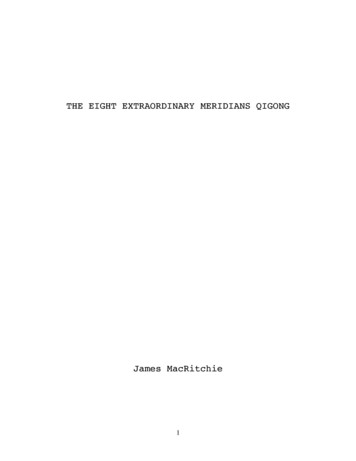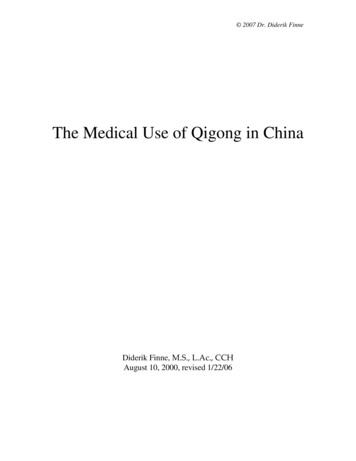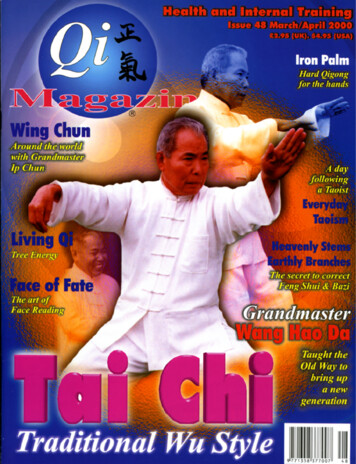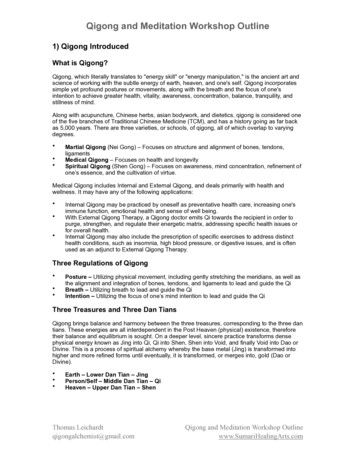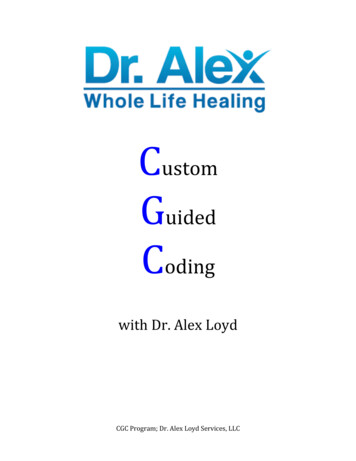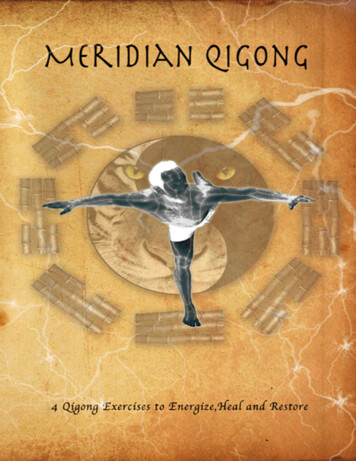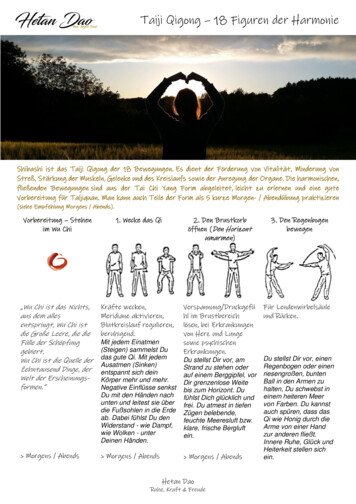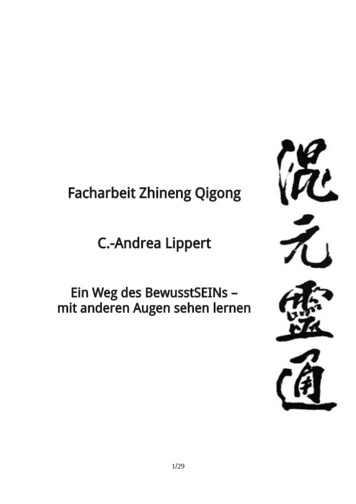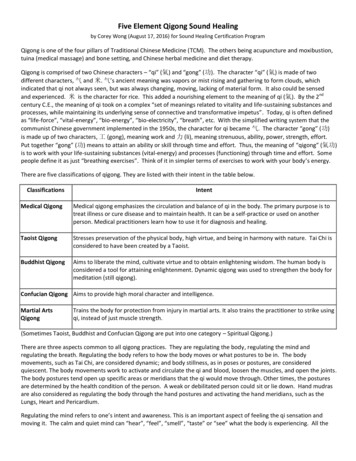
Transcription
Five Element Qigong Sound Healingby Corey Wong (August 17, 2016) for Sound Healing Certification ProgramQigong is one of the four pillars of Traditional Chinese Medicine (TCM). The others being acupuncture and moxibustion,tuina (medical massage) and bone setting, and Chinese herbal medicine and diet therapy.Qigong is comprised of two Chinese characters – “qi” (氣) and “gong” (功). The character “qi” (氣) is made of twodifferent characters, 气 and 米. 气’s ancient meaning was vapors or mist rising and gathering to form clouds, whichindicated that qi not always seen, but was always changing, moving, lacking of material form. It also could be sensedand experienced. 米 is the character for rice. This added a nourishing element to the meaning of qi (氣). By the 2ndcentury C.E., the meaning of qi took on a complex “set of meanings related to vitality and life-sustaining substances andprocesses, while maintaining its underlying sense of connective and transformative impetus”. Today, qi is often definedas “life-force”, “vital-energy”, “bio-energy”, “bio-electricity”, “breath”, etc. With the simplified writing system that thecommunist Chinese government implemented in the 1950s, the character for qi became 气. The character “gong” (功)is made up of two characters, 工 (gong), meaning work and 力 (li), meaning strenuous, ability, power, strength, effort.Put together “gong” (功) means to attain an ability or skill through time and effort. Thus, the meaning of “qigong” (氣功)is to work with your life-sustaining substances (vital-energy) and processes (functioning) through time and effort. Somepeople define it as just “breathing exercises”. Think of it in simpler terms of exercises to work with your body’s energy.There are five classifications of qigong. They are listed with their intent in the table below.ClassificationsIntentMedical QigongMedical qigong emphasizes the circulation and balance of qi in the body. The primary purpose is totreat illness or cure disease and to maintain health. It can be a self-practice or used on anotherperson. Medical practitioners learn how to use it for diagnosis and healing.Taoist QigongStresses preservation of the physical body, high virtue, and being in harmony with nature. Tai Chi isconsidered to have been created by a Taoist.Buddhist QigongAims to liberate the mind, cultivate virtue and to obtain enlightening wisdom. The human body isconsidered a tool for attaining enlightenment. Dynamic qigong was used to strengthen the body formeditation (still qigong).Confucian Qigong Aims to provide high moral character and intelligence.Martial ArtsQigongTrains the body for protection from injury in martial arts. It also trains the practitioner to strike usingqi, instead of just muscle strength.(Sometimes Taoist, Buddhist and Confucian Qigong are put into one category – Spiritual Qigong.)There are three aspects common to all qigong practices. They are regulating the body, regulating the mind andregulating the breath. Regulating the body refers to how the body moves or what postures to be in. The bodymovements, such as Tai Chi, are considered dynamic; and body stillness, as in poses or postures, are consideredquiescent. The body movements work to activate and circulate the qi and blood, loosen the muscles, and open the joints.The body postures tend open up specific areas or meridians that the qi would move through. Other times, the posturesare determined by the health condition of the person. A weak or debilitated person could sit or lie down. Hand mudrasare also considered as regulating the body through the hand postures and activating the hand meridians, such as theLungs, Heart and Pericardium.Regulating the mind refers to one’s intent and awareness. This is an important aspect of feeling the qi sensation andmoving it. The calm and quiet mind can “hear”, “feel”, “smell”, “taste” or “see” what the body is experiencing. All the
senses can be heighten. Then, with one’s intent the qi will move and the qi will follow the intent. Visualization orguided imagery is also used in regulating the mind.Regulating the breath refers to how one breathes. There are many breathing techniques in qigong. Some techniquesactivate the body and the qi. Others calm down the body and still move the qi. There are many beneficial physiologicaleffects of controlled breathing, especially deep, slow breathing. One of them is to regulate the autonomic nervoussystem by calming down the sympathetic nervous system and activating the parasympathetic nervous system, which willimprove physiological functions and the immune system. Another important point with regulating the breath is onexhalation. A sound can be produced with a certain frequency and vibration to resonate with the body and organs. Ifthe organ’s energetic function is in disharmony, a sound can be used to regulate it back into harmony. Qigong hasseveral different methods of using sound to enhance health. Some of the sound qigong styles are the Six Sounds,Singing Qigong, and Five Elements Qigong, and within each style there are multiple variations of the sounds.Five Element Qigong is based on the Five Element Theory. The ancient Chinese philosophers developed this theorythrough watching the interactions within nature. These interactions were movements and relationships of things innature or the universe. In English, we use the term “Five Elements”, but literally translated, “wuxing” (五行) means“Five Movements”. This means that these elements are dynamic and alive. They grow and diminish and affect othermovements (or elements). The system of the Five Elements, originating from Taoism, provides the basis for harmony inuniverse, in nature and in man. All things in the world are in relationship to each other and contain in each case itself amicrocosmic representation of the universe. Accordingly, they are each assigned to the Five Elements, which the basicelements are water, wood, fire, earth and metal. Below is a table and diagram of the associations and relationships ofthe Five Elements.5 Elements - Associations in Chinese Metal(Inward)Water(Downward)Zang Organs (Yin)LiverHeartSpleenLungsKidneysFu Organs (Yang)Gall BladderSmall IntestineStomachLarge IntestineBladderHealing Sounds(Expanding)Kuo/GuoZhengGongShang----Healing Sounds(Contracting)XuHeHuSiYuMusical olorsGreen or BluegreenRedYellowWhite, Silver orGoldBlack or dark BlueEmotionsAngerJoyWorrySadness, GriefFear
ward)Water(Downward)Sense VesselsMusclesSkinBonesFluidsTearsSweatThick SalivaPhlegm/MucusSaliva utingLaughingSingingCryingGroaning or rth, GerminationGrowthTransformation,RipeningHarvest, CollectStorageSeasonsSpringSummerTransitions arsSaturnVenusMercuryYin-YangLesser YangUtmost YangCenterLesser YinUtmost YinAnimalsFishBirdsHumanMammalsShell CoveredDomestic llet
A#D#C#G#F#Since man contains equally a microcosm of the nature, thus representing the fundamental processes in nature, andsince the five elements arise from the nature, it follows that man can be analyzed in Chinese medicine in accordance tothese elements. It is the aim of that analysis to clear the organs of the person, and to strengthen them and to bring theminto a harmonic balance to each other, for that the qi can circulate freely from organ to organ and through the meridians,in order to help the body regaining a physically and emotional healthy state of being. The five elements are connectedthrough a specific cycle, in which one element feeds or creates the following one. Water feeds wood, wood fuels fire,fire creates ash which returns to the earth, earth bears metal and metal produces water. This cycle is called growth,generation or creation cycle.The second cycle is the controlling cycle, which protects against overgrowth or too much abundance. Within thecontrolling cycle, wood controls earth, earth controls water, water controls fire, fire controls metal and metal controlswood.These two cycles have a dynamic relationship which balances each other and creates a harmony among the elements.The two main disharmonies are over-controlling and insulting. Over-controlling is when one element exhibits excesscontrol on an element in the controlling cycle. Insulting is the result of a controlled element fighting back and causing areverse of the controlling direction.In the Five Elements Qigong, sounds, directions, colors and elements can be used together or separately to affect theorgan energetic functions bringing back the balance of the corresponding relations of the elements to help heal ourbodies. What is unique about the sounds is that a particular note and sound has a frequency and vibration thatresonates with the organ energies of that element. Refer to table above for notes and sound. In this Five Element
Qigong, it has a sound for expanding to activate, disperse and move, and a sound for contracting to nourish and tonify,for each element, except for water. The water element’s yin organ’s qi, the Kidney qi, should not be dispersed, buttonified. This qi is connected to the dantian qi, which is our body’s “bank of qi” and we want to keep it full as possible.The Kidney qi nourishes all other organ qi, thus, we want to protect it and not lose it. Age and an unhealthy lifestyle willdeplete the Kidney qi! Many qigong styles practice to keep that qi strong.In conclusion, practicing most any qigong will be a healthy addition to one’s lifestyle and will improve one’s health. Aqigong that includes sound, such as the Five Element Qigong, will bring another aspect of healing to the body. Theresonating vibration of the sound’s frequency will carry the intention to benefit the organ’s energy. The more we can dofor ourselves, the healthier we will be.
Qigong is one of the four pillars of Traditional Chinese Medicine (TCM). The others being acupuncture and moxibustion, tuina (medical massage) and bone setting, and Chinese herbal medicine and diet therapy. Qigong is comprised of two Chinese characters - "qi" (氣) and "gong" (功). The character "qi" (氣) is made of two
